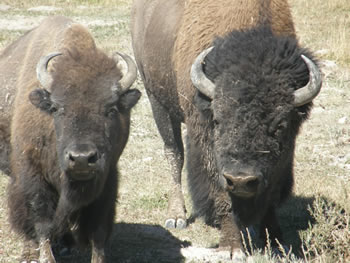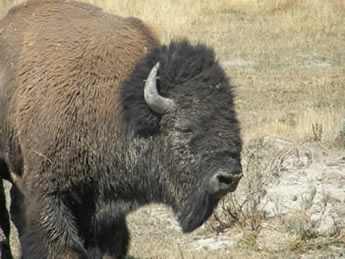|
| |
 |
| | |
#2 - The American Bison (Buffalo)
|
| |
It is hard to think of the great plains of North American without imagining vast
herds
of the majestic American Bison, Bison bison, which once roamed and migrated freely.
|
| |
It is estimated that over 60 million bison roamed across the continent from southeastern Yukon, across to the Appalachians and down to Northern Mexico.
By the end of the 19th century, there were about 500 American Bison left.
Today, they are found primarily in protected areas especially Wood Buffalo National Park, Alberta and Yellowstone Nation Park. |
|
This beautiful beast is easily recognized with its high hump at the shoulders, short tail and dense, shaggy hair on the head and neck and long (12 inches) beard. The head of American Bison appears to be very large in relation to the rest of the body, but in fact it is of the same proportion as in cats and dogs.
|
| |
|
|
The females looks very similar to the male, but is much smaller, as shown in the image on the left. Both sexes have short, round horns which curve upwards. A
single calf weighing 40 lbs (18 kg) is usually born in May. Within a few hours it is able to follow the cow and within a week is able to graze. Both parents help care for the young.
This is also the most dangerous season with the melting ice of the rivers and lakes. Safe enough in the hard days of winter but often fatal in the spring.
As summer approaches the bison shed their heavy winter coats. Now though, is the time for irritating flies To escape these torments bison regularly have dust baths or wallow in the marshes and wetlands. |
Much of the hot summer day time is spent bedded down, ruminating. Bison enjoy autumn as the flies have gone and the ripening grasses are at their best. They graze much like the domestic cattle. |
| | |
|
|
|
The prairie buffalo is a slow plodding animal not particularly intelligent and with the shaggy hairs covering its eyes and ears it was easy prey for the hunters. There are two subspecies of bison: The Plains (shown on this page) and the larger Wood Bison. |
| |
|
|
|
| | |
|
| | |
| Dereila Nature Inn Home > Woodlands Pathway > Mammals Wildzone > Walking in the Wild > The American Bison |
|
|
Home | All Things Natural Restaurant | Bird's Nest Lounge | Cyber Room | Lagoon Trail | Naturalist's Nook | Wildflower Garden | Woodlands Pathway
Site Map | Inbox | FAQs | News and Updates | Newsletter Information | Games Room | Privacy Policy
All content © Dereila and Sage Innovations
|







